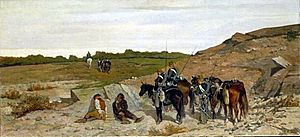Brigandage in the Two Sicilies
| Brigantaggio | |||||||
|---|---|---|---|---|---|---|---|
| Part of Italian Unification | |||||||
 An episode of the Brigantaggio in 1864 |
|||||||
|
|||||||
| Belligerents | |||||||
|
|
Briganti (South Italian Brigands) |
||||||
| Commanders and leaders | |||||||
|
Alfonso La Marmora Enrico Cialdini |
Carmine Crocco Ninco Nanco † |
||||||
| Casualties and losses | |||||||
| (1861-1864) 603 KIA incl. 21 Officers 253 WIA 24 POW/MIA |
(1861-1864) 2,413 KIA 2,768 captured of which 1,038 executed |
||||||
Brigandage in Southern Italy had existed in some form since ancient times. However its origins as outlaws targeting random travellers would evolve vastly later on in the form of the political resistance movement. During the time of the Napoleonic conquest of the Kingdom of Naples, the first signs of political resistance brigandage came to public light, as the Bourbon loyalists of the country refused to accept the new Bonapartist rulers and actively fought against them until the Bourbon monarchy had been reinstated. Some claim that the word brigandage is a euphemism for what was in fact a civil war.
In the upheaval of Sicily's transition out of feudalism in 1812, and the resulting lack of an effective government police force banditry became a serious problem in much of rural Sicily during the 19th-century. Rising food prices, the loss of public and church lands, and the loss of feudal common rights pushed many desperate peasants to banditry.
With no police to call upon, local elites in countryside towns recruited young men into "companies-at-arms" to hunt down thieves and negotiate the return of stolen property, in exchange for a pardon for the thieves and a fee from the victims, a development that is often seen as the genesis of the Mafia. These companies-at-arms were often made up of former bandits and criminals, usually the most skilled and violent of them. While this saved communities the trouble of maintaining their own policemen, this may have made the companies-at-arms more inclined to collude with their former brethren rather than destroy them.
After the conquest of the Kingdom of Two Sicilies in 1861 by the Kingdom of Sardinia (later Kingdom of Italy), the most famous and well known form of brigandage in the area emerged. Social unrest, especially among the lower classes, occurred due to poor conditions, and the fact that the Risorgimento benefited in the "Mezzogiorno" only the bourgeoisie vast-land owning classes. Many turned to brigandage in the mountains of Basilicata, Campania, Calabria and Abruzzo to continue the fight against the northern invaders. Amongst the brigands were a mixture of people, with different working backgrounds and motives, but the same desire to defeat the common enemy; the brigands included people who the Italian government considered criminals, many former soldiers and loyalists of the Bourbon army, but also nobles, poverty stricken farmers who had fled due to extortionate Italian taxes placed on them and peasants who wanted land reforms, both men and women took up arms.
...
Wikipedia
